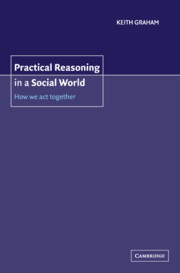Book contents
- Frontmatter
- Contents
- Preface
- Acknowledgements
- Introduction
- 1 Practical reasoning in context
- 2 The indistinctness of persons: causal interconnection
- 3 The indistinctness of persons: the personhood of collectivities
- 4 Practical collective identification and dissociation
- 5 Practical reasoning: sources and constraints
- 6 Practical reasoning and morality
- Conclusion
- Bibliography
- Index
4 - Practical collective identification and dissociation
Published online by Cambridge University Press: 22 September 2009
- Frontmatter
- Contents
- Preface
- Acknowledgements
- Introduction
- 1 Practical reasoning in context
- 2 The indistinctness of persons: causal interconnection
- 3 The indistinctness of persons: the personhood of collectivities
- 4 Practical collective identification and dissociation
- 5 Practical reasoning: sources and constraints
- 6 Practical reasoning and morality
- Conclusion
- Bibliography
- Index
Summary
The topics of this chapter are active identification with and dissociation from collectivities of the kind defined in the previous chapter. In the case of individual action, an individual may either engage wholeheartedly in what they are doing, identifying with the project they are executing, or they may engage in a curmudgeonly way, where their heart is simply not in the project (perhaps because they are coerced into it). At the extreme, their mental dissociation from their action may result in their ceasing to perform that action at all. An analogous range of attitudes from commitment to dissociation may also accompany an individual's engagement in collective action.
The exhaustive options in the relevant possible relations between individual and collectivity are described; the importance of keeping a theoretical space for the option of dissociation is argued for; and three forms of collective identification (primitive, mediated and pure collective identification) are distinguished. The aim is to draw out some of the implications for practical reasoning which follow once the existence of collectivities is recognised. In particular, I shall suggest that the model of the individual agent forming plans on the basis of individual preferences is too impoverished to account for all the practical reasoning which is called for: the option of collective identification is in certain respects sui generis. I shall introduce an initial, rudimentary description of collective identification – the first approximation – and then as the chapter proceeds I shall attempt to pinpoint a number of respects in which it requires elaboration, modification and amendment.
- Type
- Chapter
- Information
- Practical Reasoning in a Social WorldHow We Act Together, pp. 105 - 132Publisher: Cambridge University PressPrint publication year: 2002

